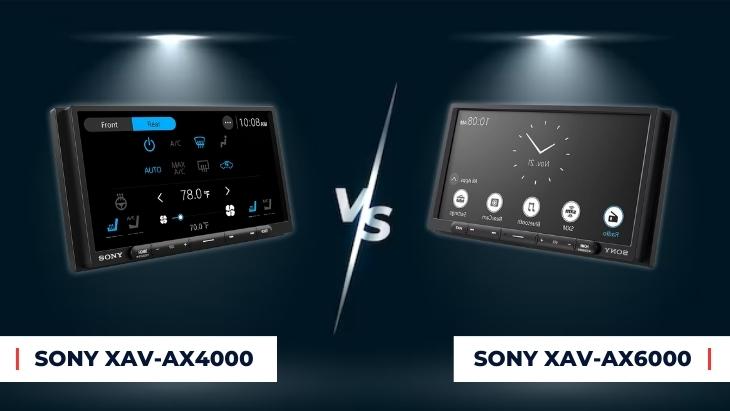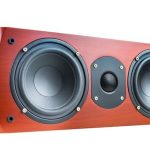Let’s be real – using your phone in the car has gone from a luxury to a necessity these days. Whether it is maps, music, or hands-free calls, you want your ride connected to your smartphone. That’s why Sony made their XAV-AX stereos fully packed with the latest tech. This article compares c stereos feature by feature.
The article will look at how the displays, smartphone syncing, menus, and audio controls stack up. It’ll highlight the perks of each model and explain which best fits different budgets and tastes.
Essentially, the XAV-AX4000 and XAV-AX6000 represent two tiers of the Sony car stereo lineup. As the numeric naming implies, the AX6000 is the higher-spec successor to the AX4000 model. However, the AX4000 still holds its own as an affordable CarPlay and Android Auto receiver thanks to a solid feature set.
These touchscreen head units seamlessly sync up with your iPhone or Android for intuitive control of tunes, navigation, and more. Plus they sound amazing with customizable audio. They give you an awesome connected driving experience.
Display Comparison
Arguably the most obvious difference between the Sony XAV-AX4000 and AX6000 lies in the screen size and display technology.
The XAV-AX4000 is equipped with a 6.95-inch resistive touch display. This means the screen relies on pressure to register touches, similar to a smartphone from the 2010-2015 era. Resistive touchscreens do not require as much precision as modern capacitive screens, but they can be prone to reduced responsiveness over time depending on usage.
In the Sony AX4000’s case, the resistive display remains snappy and lag-free for the most part. The 6.95-inch size is relatively compact yet still easy to read and tap on the go. Simple smartphone gestures like swiping and scrolling translate smoothly. Overall the AX4000’s display gets the job done capably considering its lower price point.
On the other hand, the XAV-AX6000 features a similar 6.95-inch screen size and utilizes capacitive touch technology instead. Capacitive touchscreens have become standard in smartphones and tablets in recent years. They rely on the conductive properties of the human finger to register taps and swipes rather than pressure.
This makes the AX6000’s capacitive display much more responsive with multi-touch gestures. Its better responsiveness eases use while driving. Apps and maps have a sharper, more vivid picture quality. Pinch zooming and spread gestures are fast and smooth. Overall the AX6000’s screen simply provides a much more modern and premium feel befitting a higher-end head unit.
Both Sony receivers allow adjusting the display’s dimmer, background wallpaper, and automatic power on/off. But the XAV-AX6000’s superior capacitive touchscreen gives it a major advantage for anyone who prioritizes display quality and responsiveness in their automotive stereo. The AX4000’s aged resistive screen gets the job done for smartphone mirroring and basic gestures, but can’t match the AX6000’s immersive experience.
Smartphone Connectivity and Interface
Since smartphone mirroring capability via Apple CarPlay and Android Auto is a prime selling point for both Sony units, the quality of integration and interface speed plays a big role in the user experience.
On the surface, both the Sony XAV-AX4000 vs 6000 tick the boxes for wireless Apple CarPlay and wired Android Auto compatibility. This allows you to easily access maps, music, messages, and phone functions from your iPhone or Android device on the stereo’s touchscreen. Both models also have Bluetooth hands-free calling and audio streaming.
However, the faster processing and increased touch responsiveness of the AX6000 give it a noticeably slicker performance when connected to a smartphone. Launching apps and switching between functions feels snappier compared to the small lag on the AX4000. The improved multitouch gestures of the capacitive screen also help enhance the AX6000’s smartphone experience.
The AX6000 backs its excellent connected functionality with a customizable shortcut menu that stays visible on the side of the screen. This makes it simple to jump between different apps and functions in CarPlay or Android Auto mode without having to return to the home screen. Overall the AX6000 provides a tighter, more optimized integration with your smartphone.
That said, the AX4000 still delivers a very solid Apple CarPlay and Android Auto experience for the money. Any minor lags or sluggishness in responsiveness should be relatively rare. So while the AX6000 certainly outperforms its predecessor, the AX4000 remains highly capable for most users’ needs when it comes to smartphone mirroring and daily driving use.
In terms of the general interface and menus, the XAV-AX6000 once again benefits from its more advanced hardware through smoother graphics and transitions. Everything from browsing radio stations to adjusting settings has a clean animated aesthetic lacking in the more basic AX4000 interface.
Sony also optimized the AX6000’s user experience with small enhancements like the aforementioned app shortcut menu. Overall the AX6000 provides a tighter, more modern software experience that takes fuller advantage of its powerful processor and display.
But the XAV-AX4000 hardly feels outdated or boring to use. The graphics have a simple charm and menus are logically organized for easy navigation. Those upgrading from an older, non-smart stereo will still appreciate the AX4000’s legible screen and large touch targets. So while not as flashy or responsive as the AX6000, the AX4000’s interface is serviceable.
Audio Adjustments and Sound Quality
Beyond just smartphone mirroring, a major reason to install a new car receiver is to enhance your audio experience through equalizer adjustments and built-in amplification. Here Sony’s higher-end unit once again outperforms, but the AX4000 still includes enough audio customization for most.
Both the XAV-AX4000 and AX6000 have 14-band graphic equalizers for fine-tuning the stereo’s frequency response. Preset profiles are also available if you’d prefer not to start from scratch. Sony’s Dynamic Stage Organizer and digital signal processing help provide more immersive sound with standard car speakers.
However, the AX6000 adds some additional advanced audio adjustments that the AX4000 lacks. For example, the AX6000 includes customizable Time Alignment settings to compensate for speaker distance and delay factors within the car cabin. This helps align all the sound waves for optimal staging.
You also get steeper crossover settings on the AX6000 versus AX4000 for designing over/under amplification curves. If using external amplifiers or subwoofers, the AX6000 provides more tuning flexibility. An Extra Bass boost option is available for enhancing low-end thump.
Overall the XAV-AX6000 gives the most control for fine-tuning sound quality depending on your exact car audio configuration and personal taste. Audiophiles will appreciate the AX6000’s capabilities for getting the most out of their setup. But the AX4000 still includes essential equalization and processing for achieving very good sound quality that easily beats basic factory stereos.
Both Sony receivers sound crisp and powerful right out of the box. The volume gets dangerously loud if you max it out. Highs, mids, and lows all have decent balance without glaring weaknesses. Far better audio than any smartphone, the Sony units help your music shine with optional customization taking it even further. For many buyers, the AX4000 will satisfy their audio demands unless a need for advanced tuning exists.
Additional Features and Connectivity
As flagship models in Sony’s mobile audio lineup, both the XAV-AX4000 and AX6000 come well-equipped in terms of extra capabilities. But the AX6000 does pull ahead with some unique additions.
The AX6000 adds an HD Radio tuner for accessing HD radio stations and extra metadata like song titles. You also get dual USB inputs instead of just one on the AX4000. Two rear camera inputs provide compatibility with aftermarket backup cameras, a nice safety addition.
Sony also optimized the AX6000 to provide high-resolution uncompressed audio playback when using a compatible smartphone streaming service. So if you subscribe to something like Tidal HiFi, the AX6000 will play 24-bit FLAC streaming files at top quality through its USB input.
Note that the AX6000 lacks a CD drive so you’ll have to stream your digital music library instead. But with smartphone integration and apps like Spotify, most buyers should have no problem going all-digital.
The XAV-AX4000 focuses more on value and skips the extra bells and whistles. You still get the rear USB port for plugging in a flash drive music library. Bluetooth audio, calling, and NFC tap-to-pair make connecting straightforward. So the functionality most customers need is present even if HD Radio and hi-res playback functionalities are missing.
Sony XAV-AX4000 vs 6000 Specs Comparison
To summarize the technical specs:
[amazon box=”B0B52CVLVX”]
Sony XAV-AX4000
- 6.95″ resistive touchscreen display
- 800 x 480 resolution
- Wireless Apple CarPlay
- Wired Android Auto
- Bluetooth calling and audio streaming
- Single rear USB input
- 14 band equalizer
- 20 Watt RMS x 4 amplification
- 55 Watt peak power x 4 amplification
- No CD drive
[amazon box=”B0B52FJ3ZG”]
Sony XAV-AX6000
- 6.95” capacitive touchscreen display
- 800 x 480 resolution
- Wireless Apple CarPlay
- Wired Android Auto
- Bluetooth calling and audio
- Dual rear USB inputs
- 14-band equalizer with advanced Time Alignment and crossover
- 20 Watt RMS x 4 amplification
- 55 Watt peak power x 4 amplification
- No CD drive
- HD Radio tuner
- Hi-res audio playback
- Rear camera input
Verdict: Which Model is Right for You between Sony XAV-AX4000 vs 6000?
So which Sony car stereo is the right pick – the flagship AX6000 or the affordable AX4000? Let me break it down for you.
The AX6000 is the fancy new hotness with its capacitive touchscreen and souped-up sound. If you’re really into your tunes or tech, it’s probably worth the upgrade. The display blows away the 4000 with super-sharp visuals. Your phone connects seamlessly too for easy maps and music.
But don’t count out the AX4000 – it’s still got awesome value if you just want the basics. For the price, you get surprisingly smooth Apple CarPlay and Android Auto to access your apps on the road. The screen may be smaller and not as responsive, but it handles navigation and calls like a champ. Plus the audio still rocks with customizable EQs to dial in the sound.
Here’s my advice for choosing between the two: If you’re an audiophile building a tricked-out system, the AX6000 is your pick. You’ll love fine-tuning the audio with its advanced adjustments. The vibrant display pairs perfectly with upgraded speakers.
Are you on a budget but want modern conveniences? The AX4000 has you covered with CarPlay/Android Auto at an affordable tag. Sure, it lacks extras like HD Radio but the core features are solid.
At the end of the day, most drivers will be very happy with the AX4000. But if the cost fits your budget, the AX6000 takes the experience to the next level with its stellar touchscreen interface and audio enhancements. Either way, you really can’t go wrong with Sony.
Michael Evanchuk is a San Francisco-based sound engineer with 20 years’ experience installing, troubleshooting, and repairing commercial, automotive, and household sound equipment. Evanchuk owns an auto stereo center, where he offers highly competitive car audio installation and repair services. He has written dozens of articles on different sound engineering topics, all of which have been published in leading journals, blogs, and websites.





